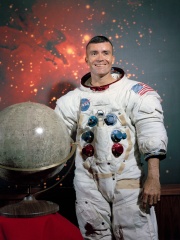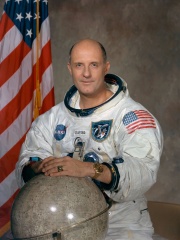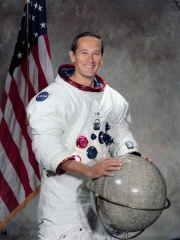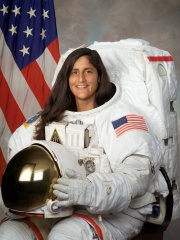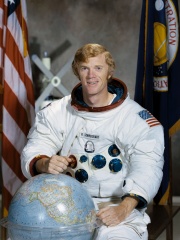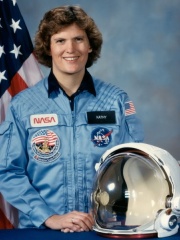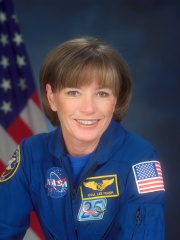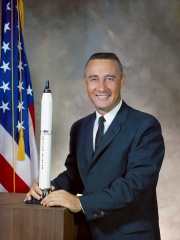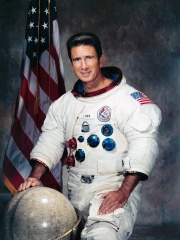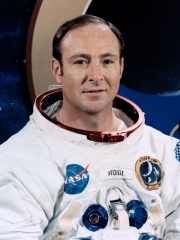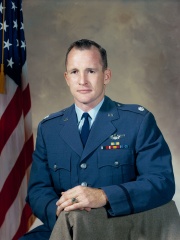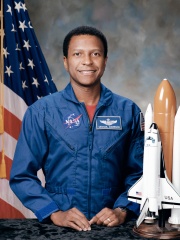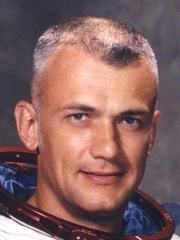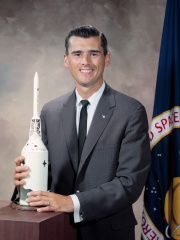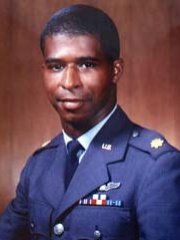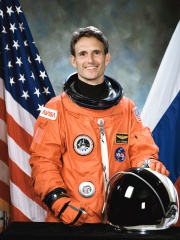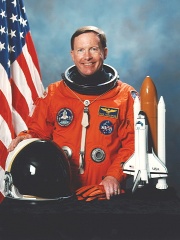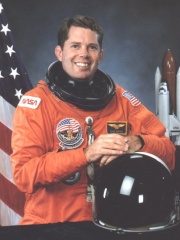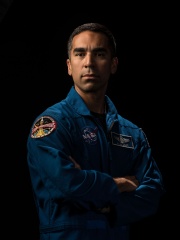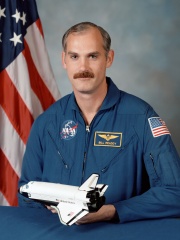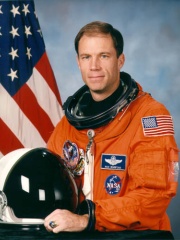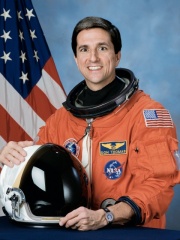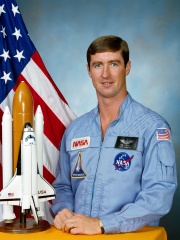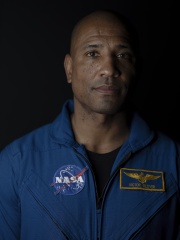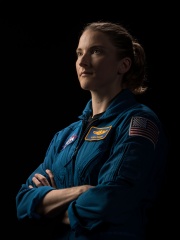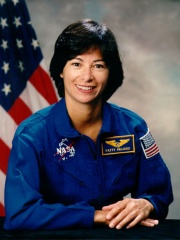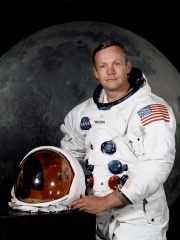
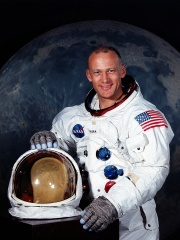
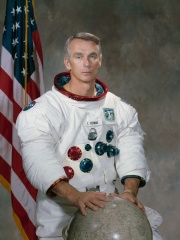
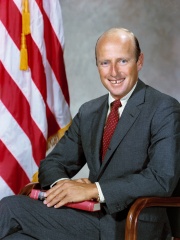
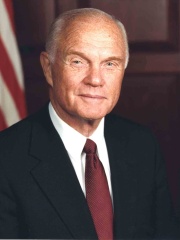
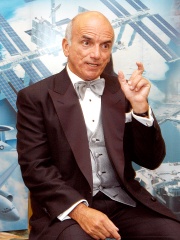
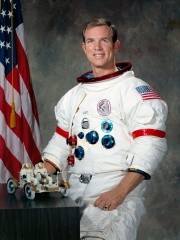
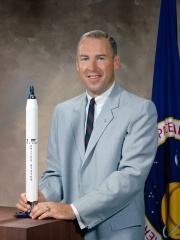
The Most Famous
ASTRONAUTS from United States
This page contains a list of the greatest American Astronauts. The pantheon dataset contains 524 Astronauts, 314 of which were born in United States. This makes United States the birth place of the most number of Astronauts.
Top 10
The following people are considered by Pantheon to be the top 10 most legendary American Astronauts of all time. This list of famous American Astronauts is sorted by HPI (Historical Popularity Index), a metric that aggregates information on a biography’s online popularity. Visit the rankings page to view the entire list of American Astronauts.

1. Neil Armstrong (1930 - 2012)
With an HPI of 84.89, Neil Armstrong is the most famous American Astronaut. His biography has been translated into 157 different languages on wikipedia.
Neil Alden Armstrong (August 5, 1930 – August 25, 2012) was an American astronaut and aeronautical engineer who in 1969 became the first person to walk on the Moon. He was also a naval aviator, test pilot, and university professor. Armstrong was born and raised in Wapakoneta, Ohio. He entered Purdue University, studying aeronautical engineering, with the U.S. Navy paying his tuition under the Holloway Plan. He became a midshipman in 1949 and a naval aviator the following year. He saw action in the Korean War, flying the Grumman F9F Panther from the aircraft carrier USS Essex. After the war, he completed his bachelor's degree at Purdue and became a test pilot at the National Advisory Committee for Aeronautics (NACA) High-Speed Flight Station at Edwards Air Force Base in California. He was the project pilot on Century Series fighters and flew the North American X-15 seven times. He was also a participant in the U.S. Air Force's Man in Space Soonest and X-20 Dyna-Soar human spaceflight programs. Armstrong joined the NASA Astronaut Corps in the second group, which was selected in 1962. He made his first spaceflight as command pilot of Gemini 8 in March 1966, becoming NASA's first civilian astronaut to fly in space. During this mission with pilot David Scott, he performed the first docking of two spacecraft; the mission was aborted after Armstrong used some of his re-entry control fuel to stabilize a dangerous roll caused by a stuck thruster. During training for Armstrong's second and last spaceflight as commander of Apollo 11, he had to eject from the Lunar Landing Research Vehicle moments before a crash. On July 20, 1969, Armstrong and Apollo 11 Lunar Module (LM) pilot Buzz Aldrin became the first people to land on the Moon, and the next day they spent two and a half hours outside the Lunar Module Eagle spacecraft while Michael Collins remained in lunar orbit in the Apollo Command Module Columbia. When Armstrong first stepped onto the lunar surface, he famously said: "That's one small step for [a] man, one giant leap for mankind." It was broadcast live to an estimated 530 million viewers worldwide. Apollo 11 was a major U.S. victory in the Space Race, by fulfilling a national goal proposed in 1961 by President John F. Kennedy "of landing a man on the Moon and returning him safely to the Earth" before the end of the decade. Along with Collins and Aldrin, Armstrong was awarded the Presidential Medal of Freedom by President Richard Nixon and received the 1969 Collier Trophy. President Jimmy Carter presented him with the Congressional Space Medal of Honor in 1978, he was inducted into the National Aviation Hall of Fame in 1979, and with his former crewmates received the Congressional Gold Medal in 2009. After he resigned from NASA in 1971, Armstrong taught in the Department of Aerospace Engineering at the University of Cincinnati until 1979. He served on the Apollo 13 accident investigation and on the Rogers Commission, which investigated the Space Shuttle Challenger disaster. In 2012, Armstrong died due to complications resulting from coronary bypass surgery, at the age of 82.

2. Buzz Aldrin (1930 - )
With an HPI of 72.64, Buzz Aldrin is the 2nd most famous American Astronaut. His biography has been translated into 97 different languages.
Buzz Aldrin (; born Edwin Eugene Aldrin Jr.; January 20, 1930) is an American former astronaut, engineer and fighter pilot. He made three spacewalks as pilot of the 1966 Gemini 12 mission, and was the Lunar Module Eagle pilot on the 1969 Apollo 11 mission. He was the second person to walk on the Moon after mission commander Neil Armstrong. Born in Glen Ridge, New Jersey, Aldrin graduated third in the class of 1951 from the United States Military Academy at West Point with a degree in mechanical engineering. He was commissioned into the United States Air Force and served as a jet fighter pilot during the Korean War. He flew 66 combat missions and shot down two MiG-15 aircraft. After earning a Doctor of Science degree in astronautics from the Massachusetts Institute of Technology (MIT), Aldrin was selected as a member of NASA's Astronaut Group 3, making him the first astronaut with a doctoral degree. His doctoral thesis, Line-of-Sight Guidance Techniques for Manned Orbital Rendezvous, earned him the nickname "Dr. Rendezvous" from fellow astronauts. His first space flight was in 1966 on Gemini 12, during which he spent over five hours on extravehicular activity. Three years later, Aldrin set foot on the Moon at 03:15:16 on July 21, 1969 (UTC), nineteen minutes after Armstrong first touched the surface, while command module pilot Michael Collins remained in lunar orbit. A Presbyterian elder, Aldrin became the first person to hold a religious ceremony on the Moon when he privately took communion. After leaving NASA in 1971, Aldrin became Commandant of the U.S. Air Force Test Pilot School. He retired from the Air Force in 1972 after 21 years of service. His autobiographies Return to Earth (1973) and Magnificent Desolation (2009) recount his struggles with clinical depression and alcoholism in the years after leaving NASA. Aldrin continues to advocate for space exploration, particularly a human mission to Mars. He developed the Aldrin cycler, a special spacecraft trajectory that makes travel to Mars more efficient in terms of time and propellant. He has been accorded numerous honors, including the Presidential Medal of Freedom in 1969.

3. Gene Cernan (1934 - 2017)
With an HPI of 71.58, Gene Cernan is the 3rd most famous American Astronaut. His biography has been translated into 53 different languages.
Eugene Andrew Cernan (; March 14, 1934 – January 16, 2017) was an American astronaut, naval aviator, electrical engineer, aeronautical engineer, and fighter pilot. During the Apollo 17 mission, Cernan became the 11th human being to walk on the Moon. As he re-entered the Apollo Lunar Module after Harrison Schmitt on their third and final lunar excursion, he remains the most recent person to walk on the Moon. Before becoming an astronaut, Cernan graduated with a Bachelor of Science degree in electrical engineering from Purdue University in Indiana, and joined the U.S. Navy through the Naval Reserve Officers Training Corps (NROTC). After flight training, he received his naval aviator wings and served as a fighter pilot. In 1963, he received a Master of Science degree in aeronautical engineering from the U.S. Naval Postgraduate School. Achieving the rank of captain, he retired from the Navy in 1976. Cernan traveled into space three times and to the Moon twice: as pilot of Gemini 9A in June 1966, as lunar module pilot of Apollo 10 in May 1969, and as commander of Apollo 17 in December 1972, the final Apollo lunar landing. Cernan was also a backup crew member of the Gemini 12, Apollo 7 and Apollo 14 space missions.

4. Pete Conrad (1930 - 1999)
With an HPI of 68.70, Pete Conrad is the 4th most famous American Astronaut. His biography has been translated into 48 different languages.
Charles "Pete" Conrad Jr. (June 2, 1930 – July 8, 1999) was an American NASA astronaut, aeronautical engineer, naval officer, aviator, and test pilot, and commanded the Apollo 12 space mission, on which he became the third person to walk on the Moon. Conrad was selected for NASA's second astronaut class in 1962. Conrad had dyslexia and yet earned his Bachelor of Science degree in Aeronautical Engineering from Princeton University—being the first Ivy League astronaut—and joined the U.S. Navy. In 1954 he received his naval aviator wings, served as a fighter pilot and, after graduating from the U.S. Naval Test Pilot School (Class 20), as a project test pilot. In 1959 he was an astronaut candidate for Project Mercury. Conrad set an eight-day space endurance record in 1965 along with his Command Pilot Gordon Cooper on his first spaceflight, Gemini 5. Later, Conrad commanded Gemini 11 in 1966, and Apollo 12 in 1969. After Apollo, he commanded Skylab 2, the first crewed Skylab mission, in 1973. On the mission, he and his crewmates repaired significant launch damage to the Skylab space station. For this, President Jimmy Carter awarded him the Congressional Space Medal of Honor in 1978. After Conrad retired from NASA and the Navy in 1973, he became a vice president of American Television and Communications Company. He went on to work for McDonnell Douglas, as a vice president. During his tenure, he served as vice president of marketing, senior vice president of marketing, staff vice president of international business development, and vice president of project development. He died on July 8, 1999, from internal injuries sustained in a motorcycle accident, aged 69.
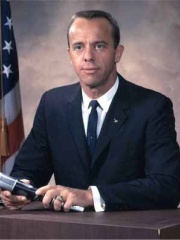
5. Alan Shepard (1923 - 1998)
With an HPI of 66.75, Alan Shepard is the 5th most famous American Astronaut. His biography has been translated into 61 different languages.
Alan Bartlett Shepard Jr. (November 18, 1923 – July 21, 1998) was an American astronaut. In 1961, he became the second person and the first American to travel into space and, in 1971, he became the fifth and oldest person to walk on the Moon, at age 47. A graduate of the United States Naval Academy at Annapolis, Shepard saw action with the surface navy during World War II. He became a naval aviator in 1947, and a test pilot in 1950. He was selected as one of the original NASA Mercury Seven astronauts in 1959, and in May 1961 he made the first crewed Project Mercury flight, Mercury-Redstone 3, in a spacecraft he named Freedom 7. His craft entered space, but was not capable of achieving orbit. He became the second person, and the first American, to travel into space. In the final stages of Project Mercury, Shepard was scheduled to pilot the Mercury-Atlas 10 (MA-10), which was planned as a three-day mission. He named Mercury Spacecraft 15B Freedom 7 II in honor of his first spacecraft, but the mission was canceled. Shepard was designated as the commander of the first crewed Project Gemini mission, but was grounded in October 1963 due to Ménière's disease, an inner-ear ailment that caused episodes of extreme dizziness and nausea. This was surgically corrected in 1968, and in 1971, Shepard commanded the Apollo 14 mission, piloting the Apollo Lunar Module Antares. He was the only one of the Mercury Seven astronauts to walk on the Moon. During the mission, he hit two golf balls on the lunar surface. Shepard was Chief of the Astronaut Office from November 1963 to August 1969 (the approximate period of his grounding), and from June 1971 until April 30, 1974. On August 25, 1971, he was promoted to rear admiral, the first astronaut to reach that rank. He retired from the United States Navy and NASA on July 31, 1974.

6. John Glenn (1921 - 2016)
With an HPI of 65.44, John Glenn is the 6th most famous American Astronaut. His biography has been translated into 72 different languages.
John Herschel Glenn Jr. (July 18, 1921 – December 8, 2016) was an American Marine Corps aviator, astronaut, businessman, and politician. He was the third American in space, and the first American to orbit the Earth, circling it three times in 1962. Following his retirement from NASA, he served from 1974 to 1999 as a U.S. Senator from Ohio; in 1998, he flew into space again at the age of 77. Before joining NASA, Glenn was a distinguished fighter pilot in World War II, the Chinese Civil War and the Korean War. He shot down three MiG-15s, and was awarded six Distinguished Flying Crosses and eighteen Air Medals. In 1957, he made the first supersonic transcontinental flight across the United States. His on-board camera took the first continuous, panoramic photograph of the United States. He was one of the Mercury Seven, military test pilots selected in 1959 by NASA as the nation's first astronauts. On February 20, 1962, Glenn flew the Friendship 7 mission, becoming the first American to orbit the Earth, the third American and fifth person in history to be in space. He received the NASA Distinguished Service Medal in 1962, the Congressional Space Medal of Honor in 1978, was inducted into the U.S. Astronaut Hall of Fame in 1990, and received the Presidential Medal of Freedom in 2012. Glenn resigned from NASA in January 1964. A member of the Democratic Party, Glenn was first elected to the Senate in 1974 and served for 24 years, until January 1999. In 1998, at age 77, Glenn flew on Space Shuttle Discovery's STS-95 mission, making him the oldest person to enter Earth orbit, the only person to fly in both the Mercury and the Space Shuttle programs, and the first Member of Congress to visit space since Congressman Bill Nelson (D-FL) in 1986. Glenn, both the oldest and the last surviving member of the Mercury Seven, died at the age of 95 on December 8, 2016.

7. Dennis Tito (1940 - )
With an HPI of 62.13, Dennis Tito is the 7th most famous American Astronaut. His biography has been translated into 47 different languages.
Dennis Anthony Tito (born August 8, 1940) is an American engineer and entrepreneur. In mid-2001, he became the first space tourist to fund his own trip into space, when he spent nearly eight days in orbit as a crew member of ISS EP-1, a visiting mission to the International Space Station. This mission was launched by the spacecraft Soyuz TM-32, and was landed by Soyuz TM-31.

8. David Scott (1932 - )
With an HPI of 61.44, David Scott is the 8th most famous American Astronaut. His biography has been translated into 44 different languages.
David Randolph Scott (born June 6, 1932) is an American retired test pilot and NASA astronaut who was the seventh person to walk on the Moon. Selected as part of the third group of astronauts in 1963, Scott flew to space three times and commanded Apollo 15, the fourth lunar landing; he is one of four surviving Moon walkers and the only living commander of a spacecraft that landed on the Moon. Before becoming an astronaut, Scott graduated from the United States Military Academy at West Point and joined the Air Force. After serving as a fighter pilot in Europe, he graduated from the Air Force Experimental Test Pilot School (Class 62C) and the Aerospace Research Pilot School (Class IV). Scott retired from the Air Force in 1975 with the rank of colonel, and more than 5,600 hours of logged flying time. As an astronaut, Scott made his first flight into space as a pilot of the Gemini 8 mission, along with Neil Armstrong, in March 1966, spending just under eleven hours in low Earth orbit. He would have been the second American astronaut to walk in space had Gemini 8 not made an emergency abort. Scott then spent ten days in orbit in March 1969 as Command Module Pilot of Apollo 9, a mission that extensively tested the Apollo spacecraft, along with Commander James McDivitt and Lunar Module Pilot Rusty Schweickart. After backing up Apollo 12, Scott made his third and final flight into space as commander of the Apollo 15 mission, the fourth crewed lunar landing and the first J mission. Scott and James Irwin remained on the Moon for three days. Following their return to Earth, Scott and his crewmates fell from favor with NASA after it was disclosed that they had carried four hundred unauthorized postal covers to the Moon. After serving as director of NASA's Dryden Flight Research Center in California, Scott retired from the agency in 1977. Since then, he has worked on a number of space-related projects and served as a consultant for several films about the space program, including Apollo 13.

9. Jim Lovell (1928 - )
With an HPI of 60.65, Jim Lovell is the 9th most famous American Astronaut. His biography has been translated into 44 different languages.
James Arthur Lovell Jr. ( LUV-əl; born March 25, 1928) is an American retired astronaut, naval aviator, test pilot and mechanical engineer. In 1968, as command module pilot of Apollo 8, he became, with Frank Borman and William Anders, one of the first three astronauts to fly to and orbit the Moon. He then commanded the Apollo 13 lunar mission in 1970 which, after a critical failure en route, looped around the Moon and returned safely to Earth. A graduate of the United States Naval Academy in Annapolis, Maryland, in the class of 1952, Lovell flew F2H Banshee night fighters. This included a Western Pacific deployment aboard the aircraft carrier USS Shangri-La. In January 1958, he entered a six-month test pilot training course at the Naval Air Test Center at Naval Air Station Patuxent River, Maryland, with Class 20 and graduated at the top of the class. He was then assigned to Electronics Test, working with radar, and in 1960 he became the Navy's McDonnell Douglas F-4 Phantom II program manager. The following year he became a flight instructor and safety engineering officer at Naval Air Station Oceana in Virginia Beach, Virginia, and completed Aviation Safety School at the University of Southern California. Lovell was not selected by NASA as one of the Mercury Seven astronauts due to a temporarily high bilirubin count. He was accepted in September 1962 as one of the second group of astronauts needed for the Gemini and Apollo programs. Prior to Apollo, Lovell flew in space on two Gemini missions, Gemini 7 (with Borman) in 1965 and Gemini 12 in 1966. He was the first person to fly into space four times. One of 24 people to have flown to the Moon, Lovell was the first to fly to it twice. He is a recipient of the Congressional Space Medal of Honor and the Presidential Medal of Freedom. He co-authored the 1994 book Lost Moon, on which the 1995 film Apollo 13 was based. Lovell was featured in a cameo appearance in the film.
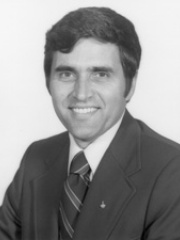
10. Harrison Schmitt (1935 - )
With an HPI of 60.34, Harrison Schmitt is the 10th most famous American Astronaut. His biography has been translated into 42 different languages.
Harrison Hagan "Jack" Schmitt (born July 3, 1935) is an American geologist, former NASA astronaut, university professor, former U.S. senator from New Mexico, and the most recent living person—and only person without a background in military aviation—to have walked on the Moon. In December 1972, as one of the crew on board Apollo 17, Schmitt became the first member of NASA's first scientist-astronaut group to fly in space. As Apollo 17 was the last of the Apollo missions, he also became the twelfth and second-youngest person to set foot on the Moon and the second-to-last person to step off of the Moon (he boarded the Lunar Module shortly before commander Eugene Cernan). Schmitt also remains the only professional scientist to have flown beyond low Earth orbit and to have visited the Moon. He was influential within the community of geologists supporting the Apollo program and, before starting his own preparations for an Apollo mission, had been one of the scientists training those Apollo astronauts chosen to visit the lunar surface. Schmitt resigned from NASA in August 1975 to run for election to the United States Senate as a member from New Mexico. As the Republican candidate in the 1976 election, he defeated Democratic incumbent Joseph Montoya. In the 1982 election, Schmitt was defeated by Democrat Jeff Bingaman.
Pantheon has 314 people classified as astronauts born between 1921 and 1987. Of these 314, 235 (74.84%) of them are still alive today. The most famous living astronauts include Buzz Aldrin, Dennis Tito, and David Scott. The most famous deceased astronauts include Neil Armstrong, Gene Cernan, and Pete Conrad. As of April 2022, 13 new astronauts have been added to Pantheon including Robert Henry Lawrence Jr., Jerry M. Linenger, and Richard N. Richards.
Living Astronauts
Go to all Rankings
Buzz Aldrin
1930 - Present
HPI: 72.64
Dennis Tito
1940 - Present
HPI: 62.13
David Scott
1932 - Present
HPI: 61.44
Jim Lovell
1928 - Present
HPI: 60.65
Harrison Schmitt
1935 - Present
HPI: 60.34
Fred Haise
1933 - Present
HPI: 56.36
Thomas P. Stafford
1930 - Present
HPI: 55.15
Charles Duke
1935 - Present
HPI: 53.26
Sunita Williams
1965 - Present
HPI: 51.16
Rusty Schweickart
1935 - Present
HPI: 49.05
Kathryn D. Sullivan
1951 - Present
HPI: 48.71
Anna Lee Fisher
1949 - Present
HPI: 48.60

Deceased Astronauts
Go to all Rankings
Neil Armstrong
1930 - 2012
HPI: 84.89
Gene Cernan
1934 - 2017
HPI: 71.58
Pete Conrad
1930 - 1999
HPI: 68.70
Alan Shepard
1923 - 1998
HPI: 66.75
John Glenn
1921 - 2016
HPI: 65.44
Gus Grissom
1926 - 1967
HPI: 59.36
James Irwin
1930 - 1991
HPI: 59.32
Edgar Mitchell
1930 - 2016
HPI: 58.99
Ed White
1930 - 1967
HPI: 58.98
Michael P. Anderson
1959 - 2003
HPI: 57.72
Bruce McCandless II
1937 - 2017
HPI: 57.62
Roger B. Chaffee
1935 - 1967
HPI: 57.40

Newly Added Astronauts (2022)
Go to all Rankings
Robert Henry Lawrence Jr.
1935 - 1967
HPI: 36.99
Jerry M. Linenger
1955 - Present
HPI: 34.07
Richard N. Richards
1946 - Present
HPI: 33.17
David Leestma
1949 - Present
HPI: 32.94
Raja Chari
1977 - Present
HPI: 32.86
William F. Readdy
1952 - Present
HPI: 31.72
Richard A. Searfoss
1956 - 2018
HPI: 30.14
Donald A. Thomas
1955 - Present
HPI: 29.37
Terence T. Henricks
1952 - Present
HPI: 29.00
Victor J. Glover
1976 - Present
HPI: 28.98
Kayla Barron
1987 - Present
HPI: 28.97
Patricia Robertson
1963 - 2001
HPI: 27.82

Which Astronauts were alive at the same time? This visualization shows the lifespans of the 25 most globally memorable Astronauts since 1700.

